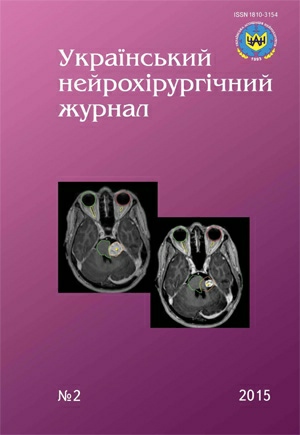Experience in the use of pneumatic high-speed drill in spinal trauma surgery
DOI:
https://doi.org/10.25305/unj.45303Keywords:
combat trauma, spinal trauma, medical drill, laminoplasty, corporectomyAbstract
For adequate access to spinal nerve structures, less traumatic resection of bone structures use of high-speed drill is advisable.
In 33 patients with spinal trauma surgery was performed using high-speed pneumatic drill “Midas Rex Legend” (Medtronic).
Conclusions. 1. The advantages of medical drill are: decrease in physical activity for a surgeon when handling to the spine bone structure; good anatomical access to spine structures; trauma reduction of nerve and bone structures of the spine.
2. To improve access to the neural canal and partial resection of the bone structures of the spine use a high-speed drill is preferable.
3. Drill use gives the possibility to perform organpreserving spinal surgery.
4. Surgical approach using high-speed drill gives the possibility to expand indications for manipulations in hard-to-reach anatomical areas of the spine.
References
Beer R, Chiel H, Quinn R, Ritzmann R. Biorobotic approaches to the study of motor systems. Current Opinion in Neurobiology. 1998;8(6):777-782. CrossRef
Dyas F. The treatment of acute osteomyelitis of the long bones by means of the dental engine and a large burr: preliminary report. Journal of the American Medical Association. 1914;LXII(16):1216. CrossRef
Articles. Power Tools In Orthopaedic Surgery - An Update - Orthopaedic Product News. Orthopaedic Product News. 2008. [cited 2014 December 17]. Available from URL
Kawai S, Sunago K, Doi K, Saika M, Taguchi T. Cervical laminoplasty (Hattori's method). Procedure and follow-up results. Spine. 1988;13(11):1245-1250. CrossRef
Kurtz A. Chronic Osteomyelitis: Operation with Large Drill and High-Speed Motor. J Bone Joint Surg Am. 1930;12(1):182-183. [Publisher Full Text]
Vieweg U, Grochulla F. Manual Of Spine Surgery. Berlin: Springer; 2012.
Chiba K, Ogawa Y, Ishii K, Takaishi H, Nakamura M, Maruiwa H, Matsumoto M, Toyama Y. Long-term Results of Expansive Open-Door Laminoplasty for Cervical Myelopathy - Average 14-Year Follow-up Study. Spine. 2006;31(26):2998-3005. CrossRef
Hirabayashi K, Watanabe K, Wakano K, Suzuki N, Satomi K, Ishii Y. Expansive Open-Door Laminoplasty for Cervical Spinal Stenotic Myelopathy. Spine. 1983;8(7):693-699. CrossRef
Nakamura K. History of laminoplasty. In: Nakamura K, Toyama Y, Hoshino Y, ed. Cervical Laminoplasty. Tokyo: Springer; 2003:3–11.
Ratliff J, Cooper P. Cervical laminoplasty: a critical review. Journal of Neurosurgery: Spine. 2003;98(3):230-238. CrossRef
Salkov ММ. [Surgical treatment of patients with spinal cord injury, using tightening clamps with shape-memory effect]. Ukrainian Neurosurgical Journal. 2014;(2):42–47. Russian. [Abstract/Full Text]
Downloads
Published
How to Cite
Issue
Section
License
Copyright (c) 2015 Mykola Salkov

This work is licensed under a Creative Commons Attribution 4.0 International License.
Ukrainian Neurosurgical Journal abides by the CREATIVE COMMONS copyright rights and permissions for open access journals.
Authors, who are published in this Journal, agree to the following conditions:
1. The authors reserve the right to authorship of the work and pass the first publication right of this work to the Journal under the terms of Creative Commons Attribution License, which allows others to freely distribute the published research with the obligatory reference to the authors of the original work and the first publication of the work in this Journal.
2. The authors have the right to conclude separate supplement agreements that relate to non-exclusive work distribution in the form of which it has been published by the Journal (for example, to upload the work to the online storage of the Journal or publish it as part of a monograph), provided that the reference to the first publication of the work in this Journal is included.









